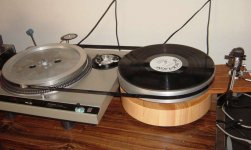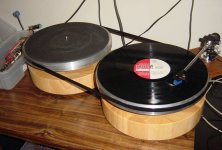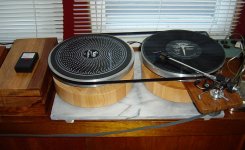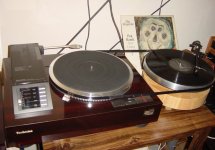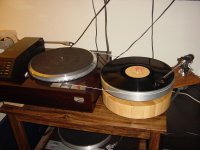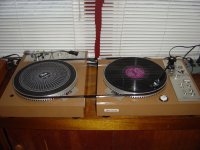Here is what I have been up to. Using a Technics SL-1700mk2 (same thing as SL-1600mk2 & SL-1800mk2 with different auto functions and same motor as SL-1200mk2) belt driving an Empire 208 platter and bearing housed in a butcher block with Audiocraft AC300 tonearm and Denon DL-103 cartridge. Let's just think of the Technics as a giant motor pod with an extremely accurate and silent motor. The speed/pitch adjustment is handy to compensate the discrepancy between the two platters diameter. Practically this will work for any belt drive turntable.
I love the Papst motor from the Empire but it's simply not quiet enough and the fan noise is a nuisance. Those belt-drive Teres owners take note. Your motor might be great but give this "big" motor try. You might like it. Belt is from VHS tape and works much better than dental floss or similar material. I might try 8mm or 16mm film as it does not stretch at all. The less elastic the material the cleaner the sound which of course really depends on the quality your motor. No more rubber belts for me. Let the motor drive the platter and not the other way around.
Before anyone spend their big bucks on the next manufacture "upgrade" on a new motor or whatever for their high end turntable, do you self a favor and go get a decent direct-drive turntable with pitch control and tape drive your platter. SL-1200mk2 is perfect and if you don't like it, you can always resell it easily. The only hitch is that it takes up a lot of table space. I seriously consider building something more compact to house the DD motor assembly and electronics all underneath the platter so it's 12"x12" square size or a circle. Since the Technics platter is beveled at the edge and has strobe marks, I have to use another platter on top as adapter plate for the tape to ride on. If the active platter and passive platter is the same diameter then pitch control is not necessary - a Lenco platter stack on top of a DD table tape driving a passive Lenco platter will work!
How does it sound? EVERYTHING is cleaner and more refined. Quiet, smooth, and most important accurate. It spins and works how a turntable should be! I will spare you the pornographic adjectives. It's a TURN-table and, in this set up, it turns accurately, steadily, and quietly, and therefore, sings beautifully. It does not have the clinical or sterile sound people complain about the Technics. The VHS tape probably smooths out that last bit of microscopic rotational irregularities. To me driving the platter with a rubber belt only hides the problem with motor, its noise and speed drift or cogging. A direct drive turntable is NOT noisy, as the motor is running at 33rpm, that is HALF HERTZ. Put a stethoscope on the turntable or motor, I hear nothing. Well, except the noise from the power transformer, so there's still room for improvement. Now, a vintage AC motor like the Papst or Ashland, as great as they are, runs at 1800rpm and that's 30hz! You bet you can feel and hear the noise. The tiny bit of compliance, ie, the tape, between a DD table and a passive platter takes care of the last bit impurity in the rotation. The motor is so quiet that I actually hear more of the noise from the Empire's bearing. I probably need to put new oil in the old clunker. So, with this set up the bearing quality becomes paramount.
I am curious how this will sound on a Teres turntable as they are known for the quality bearing or any other quality turntables for that matter, especially those turntable that has a separate motor pod. Those who have tried it, let me know your result. Don't forget there are other great DD tables there so you might get an even better sound but the Technics is cheap and has high torque and great speed stability so it works for me.
Prepare to have more table space.
---------------------------------------------
Yes, I am aware of that someone did a similar set up before:
http://www.aiko.com/diy_intermediate.html
In fact, that was one of my inspirations. But he ended up using a Teres with integral motor pod. I wish he had tried to tape drive his Teres with a different DD table. I think he could have gotten better result if he used a later post-qartz era (after 1975) direct drive turntable, either a Technics or later Kenwood model. I believe the one he used was a Kenwood KD-2077 or KD-2070, the strobe marks on the platter probably prevented him from using VHS 1/2" tape. I recently tried an old direct driver, Pioneer PL-510 and probably a faulty unit, that has so much cogging that it's not even usable. So, the quality of the direct drive turntable/motor is paramount in this experiment. You can't go wrong with the Technics. I will have a KD-2070 soon and I will compare it to the Technics, but I will have to use dental floss though due to strobe marks on the platter.
----------------------------------------------
I love the Papst motor from the Empire but it's simply not quiet enough and the fan noise is a nuisance. Those belt-drive Teres owners take note. Your motor might be great but give this "big" motor try. You might like it. Belt is from VHS tape and works much better than dental floss or similar material. I might try 8mm or 16mm film as it does not stretch at all. The less elastic the material the cleaner the sound which of course really depends on the quality your motor. No more rubber belts for me. Let the motor drive the platter and not the other way around.
Before anyone spend their big bucks on the next manufacture "upgrade" on a new motor or whatever for their high end turntable, do you self a favor and go get a decent direct-drive turntable with pitch control and tape drive your platter. SL-1200mk2 is perfect and if you don't like it, you can always resell it easily. The only hitch is that it takes up a lot of table space. I seriously consider building something more compact to house the DD motor assembly and electronics all underneath the platter so it's 12"x12" square size or a circle. Since the Technics platter is beveled at the edge and has strobe marks, I have to use another platter on top as adapter plate for the tape to ride on. If the active platter and passive platter is the same diameter then pitch control is not necessary - a Lenco platter stack on top of a DD table tape driving a passive Lenco platter will work!
How does it sound? EVERYTHING is cleaner and more refined. Quiet, smooth, and most important accurate. It spins and works how a turntable should be! I will spare you the pornographic adjectives. It's a TURN-table and, in this set up, it turns accurately, steadily, and quietly, and therefore, sings beautifully. It does not have the clinical or sterile sound people complain about the Technics. The VHS tape probably smooths out that last bit of microscopic rotational irregularities. To me driving the platter with a rubber belt only hides the problem with motor, its noise and speed drift or cogging. A direct drive turntable is NOT noisy, as the motor is running at 33rpm, that is HALF HERTZ. Put a stethoscope on the turntable or motor, I hear nothing. Well, except the noise from the power transformer, so there's still room for improvement. Now, a vintage AC motor like the Papst or Ashland, as great as they are, runs at 1800rpm and that's 30hz! You bet you can feel and hear the noise. The tiny bit of compliance, ie, the tape, between a DD table and a passive platter takes care of the last bit impurity in the rotation. The motor is so quiet that I actually hear more of the noise from the Empire's bearing. I probably need to put new oil in the old clunker. So, with this set up the bearing quality becomes paramount.
I am curious how this will sound on a Teres turntable as they are known for the quality bearing or any other quality turntables for that matter, especially those turntable that has a separate motor pod. Those who have tried it, let me know your result. Don't forget there are other great DD tables there so you might get an even better sound but the Technics is cheap and has high torque and great speed stability so it works for me.
Prepare to have more table space.
---------------------------------------------
Yes, I am aware of that someone did a similar set up before:
http://www.aiko.com/diy_intermediate.html
In fact, that was one of my inspirations. But he ended up using a Teres with integral motor pod. I wish he had tried to tape drive his Teres with a different DD table. I think he could have gotten better result if he used a later post-qartz era (after 1975) direct drive turntable, either a Technics or later Kenwood model. I believe the one he used was a Kenwood KD-2077 or KD-2070, the strobe marks on the platter probably prevented him from using VHS 1/2" tape. I recently tried an old direct driver, Pioneer PL-510 and probably a faulty unit, that has so much cogging that it's not even usable. So, the quality of the direct drive turntable/motor is paramount in this experiment. You can't go wrong with the Technics. I will have a KD-2070 soon and I will compare it to the Technics, but I will have to use dental floss though due to strobe marks on the platter.
----------------------------------------------
Attachments
Here is a second experiment. This is something I've been wanting to do, using two identical platters from one direct-drive motor active platter VHS tape driving a passive platter. I can compare the sound of passive platter which is belt-drive genre and if I connect it to the power supply then it becomes a direct drive genre. Same tonearm and cartridge. Bother motors and platters are from Pioneer PL-L1000 turntables that have inverted bearings which is advantageous for belt-driving purpose.
The VHS tape is so thin that it presents no platter discrepancy between platters and requires no speed adjustment. It is running with quartz lock and the speed of the passive platter is dead on. Once set up, it's not that fiddly. Pretty straight forward.
Tonearm is Audiocraft AC-300 and cartridge is an Audioquest MC-3 high output MC cartridge.
- - - - - - - Sound Report - - - - - - - -
I first listened to VHS tape-drive and the sound is extremely pristine, pure and clean. Details are so clear and transparent that hear all the outline of the sound objects and instruments. There's delicacy to the sound with no fussiness. Everything is solid and sculpted. One very noticeable thing is that imaging is very stable compare to typical rubber belt drive - I don't think I can ever go back to a stretchy rubber belt - well, unless the motor is really noisy and jerky the elasticity might smooth out the jitters. Bass is dynamic but not as fat or bloated as idler drive. Quite honestly, the sound is so pure that I am not missing idler drive much now - but who knows if I add an idler wheel as the interface between two platters things might be different. Overall I am quite happy with the sound. The one thing I like the most is that there's no sense of overhang like those super heavy platter belt-drive table that sounded like something is dragging its feet. This set up is light footed and extremely quick in transient and response. Violin sounds silk smooth with no grain and extended without glaring or steely sounding. I like it.
Next is direct-drive but to be fair I still have the passive platter attache via the VHS tape so it might have added some damping to platter movement. Well, the sound is DIRECT. Everything sounds louder! Weird. The bass is bigger and more forward - goes to prove that the more direct coupling and less compliance helps bass dynamic. When it comes tobass, direct drive reign supreme. All the details are even more vivid as if they have been enhanced, like Photoshop enhanced detail, slightly unnatural. Hyper detail and things are more thrusting at the listener and in your face. A very exciting presentation. It's great for pop and electronic music. I might have exaggerated the sound a touch just to differentiate the sound from the tape-drive above. Other than the bass, things are very subtle compare to above. The bass is unquestionably bigger and stronger than tape-drive. I like this too but the tape-drive wins it by a nose hair. Your choice of music and system equipment might lead to different conclusion.
Once again, this is direct drive compare to TAPE drive, VHS tape in particular, and has nothing to do with rubber belt-drive which is a whole different sound and I don't have a long rubber belt to do a comparison. If you have one, let me know. But quite frankly I have no interest in ever listening to rubber belt again. If your system needs a rubber belt to sound good than there might be a problem with the motor.
Happy listening!
The VHS tape is so thin that it presents no platter discrepancy between platters and requires no speed adjustment. It is running with quartz lock and the speed of the passive platter is dead on. Once set up, it's not that fiddly. Pretty straight forward.
Tonearm is Audiocraft AC-300 and cartridge is an Audioquest MC-3 high output MC cartridge.
- - - - - - - Sound Report - - - - - - - -
I first listened to VHS tape-drive and the sound is extremely pristine, pure and clean. Details are so clear and transparent that hear all the outline of the sound objects and instruments. There's delicacy to the sound with no fussiness. Everything is solid and sculpted. One very noticeable thing is that imaging is very stable compare to typical rubber belt drive - I don't think I can ever go back to a stretchy rubber belt - well, unless the motor is really noisy and jerky the elasticity might smooth out the jitters. Bass is dynamic but not as fat or bloated as idler drive. Quite honestly, the sound is so pure that I am not missing idler drive much now - but who knows if I add an idler wheel as the interface between two platters things might be different. Overall I am quite happy with the sound. The one thing I like the most is that there's no sense of overhang like those super heavy platter belt-drive table that sounded like something is dragging its feet. This set up is light footed and extremely quick in transient and response. Violin sounds silk smooth with no grain and extended without glaring or steely sounding. I like it.
Next is direct-drive but to be fair I still have the passive platter attache via the VHS tape so it might have added some damping to platter movement. Well, the sound is DIRECT. Everything sounds louder! Weird. The bass is bigger and more forward - goes to prove that the more direct coupling and less compliance helps bass dynamic. When it comes tobass, direct drive reign supreme. All the details are even more vivid as if they have been enhanced, like Photoshop enhanced detail, slightly unnatural. Hyper detail and things are more thrusting at the listener and in your face. A very exciting presentation. It's great for pop and electronic music. I might have exaggerated the sound a touch just to differentiate the sound from the tape-drive above. Other than the bass, things are very subtle compare to above. The bass is unquestionably bigger and stronger than tape-drive. I like this too but the tape-drive wins it by a nose hair. Your choice of music and system equipment might lead to different conclusion.
Once again, this is direct drive compare to TAPE drive, VHS tape in particular, and has nothing to do with rubber belt-drive which is a whole different sound and I don't have a long rubber belt to do a comparison. If you have one, let me know. But quite frankly I have no interest in ever listening to rubber belt again. If your system needs a rubber belt to sound good than there might be a problem with the motor.
Happy listening!
Attachments
I just spliced the the ends diagonally and scotch taped it, also diagonally, on both sides. If your tape is strong enough, one side is probably better if that's side touching the platter. VHS tape works really well. Cheap, too! Much easier than dental floss. Since there's very little compliance, it can only sound as good as your motor so the better your DD table the better the sound. I haven't tried a Denon as I gave that to a friend. Technics tables works really well due to the high torque. My Sony table is really smooth. I also like the JVC. I am fond of coreless motors, very smooth sounding. The high torque core motor has great dynamic range. Make sure get a DD table that's in the Quartz lock era, typically late 70's to 80's. Many early DD tables are junk and they exhibit noticeable cogging. To me, changing motor is like changing cartridges, the sound is not subtle. Fun stuff. Try it!
thanks a lot!
I have lost my belt to my turntable (whose I'm fixing it up) and I am very reluctant to pay over 30 dollar for a simple piece of rubber. I was orginally planning to cut up 50x0.5cm from a bicycle tube and glueing the ends together with a patch on those ends to make the belt smooth.
(it's butylen, but I have also a thin bicycletube from latex)
I have lost my belt to my turntable (whose I'm fixing it up) and I am very reluctant to pay over 30 dollar for a simple piece of rubber. I was orginally planning to cut up 50x0.5cm from a bicycle tube and glueing the ends together with a patch on those ends to make the belt smooth.
(it's butylen, but I have also a thin bicycletube from latex)
"Can anyone recomend a good DC motor with low speed constant and high torque?"
Well, the best motor that has low speed constant and high torque is from a direct-drive turntable! Nothing can touch it, provide it's a good DD turntable to begin with of course.
The torque on the the Technics is very high second only to the SP10mk2. It is essentially the same motor in the ubiquitous SL-1200mk2. The only other Technics tables that would work in this scheme without using an adaptor plate for the belt are SL-M3 and SL-M2 because their platters have flat circumference for riding the tape. The main criterion is that the table must have pitch control to adjust speed to compensate the platter diameter differences.
The Pioneer PL-570 or PL-550 works great too. I've been using two identical platters and motors from the PL-L1000 without speed adjustment. Less torque than Technics but super reliable without any of the motor going backward or super fast nonsense. Sounds great too. Not as forceful as the Technis but a touch more delicate. I will list a bunch of good candidates for this type of operation in the future.
I have completely lost interest in the traditional way of driving the platter using a small motor. I even sold all my Papst motors. Once you tried to drive your platter using another platter, you will not want to go back. As long as you have table space, try it!
Well, the best motor that has low speed constant and high torque is from a direct-drive turntable! Nothing can touch it, provide it's a good DD turntable to begin with of course.
The torque on the the Technics is very high second only to the SP10mk2. It is essentially the same motor in the ubiquitous SL-1200mk2. The only other Technics tables that would work in this scheme without using an adaptor plate for the belt are SL-M3 and SL-M2 because their platters have flat circumference for riding the tape. The main criterion is that the table must have pitch control to adjust speed to compensate the platter diameter differences.
The Pioneer PL-570 or PL-550 works great too. I've been using two identical platters and motors from the PL-L1000 without speed adjustment. Less torque than Technics but super reliable without any of the motor going backward or super fast nonsense. Sounds great too. Not as forceful as the Technis but a touch more delicate. I will list a bunch of good candidates for this type of operation in the future.
I have completely lost interest in the traditional way of driving the platter using a small motor. I even sold all my Papst motors. Once you tried to drive your platter using another platter, you will not want to go back. As long as you have table space, try it!
Attachments
Don't get me wrong, I love my DD turntables but when you have 30 turntables in the house, you want to play around with them. Wouldn't you? In fact I am listening to my Kenwood direct-drive by itself and it sounds great. But tomorrow I might want to go back to my tape-drive set up. What I will never do again is to go back to a belt-drive turntable with wimpy motor with no torque. Micro Seiki was ahead of its time when they started having the motor unit separate from the platter and plinth assembly. I would love to get a MS one day and try to drive it with a DD table. That will be fun.
Turntables are like food to me. I just want different flavors. I am not into constantly chasing the best or the absolute sound or anything like that. Audio is for pleasure and they are toys for me so naturally I like to play around. Isn't that what a hobby is about?
A lot of these turntables have broken auto mechanism or broken tonearms so I just salvage the motor parts and turn them into tape-drive motors. Besides, all of this is reversible. Direct-drive, belt-drive, and idler-drive all have different sonic characters so I want to exploit their strengths.
At the end of the day, it's really the music that matters. Audio is just a mean to an end, ie, to enhance the experience and if you're a gear-head the messing around is just a bonus.
Turntables are like food to me. I just want different flavors. I am not into constantly chasing the best or the absolute sound or anything like that. Audio is for pleasure and they are toys for me so naturally I like to play around. Isn't that what a hobby is about?
A lot of these turntables have broken auto mechanism or broken tonearms so I just salvage the motor parts and turn them into tape-drive motors. Besides, all of this is reversible. Direct-drive, belt-drive, and idler-drive all have different sonic characters so I want to exploit their strengths.
At the end of the day, it's really the music that matters. Audio is just a mean to an end, ie, to enhance the experience and if you're a gear-head the messing around is just a bonus.
Well, the best motor that has low speed constant and high torque is from a direct-drive turntable! Nothing can touch it,
Not so sure about that. I'm currently playing with a design using a (very, very expensive) 3 phase ironless rotor motor from Maxon, the peak operational torque calculates out to around 15 Nm which is almost 10 times as great as that from the SP10 mk3 which was the highest torque DD from Technics (1.6Nm vs 0.6 for the SP10 mk2).
I'd played with one of these before in an idler system (Garrard 301) and it sounded fantastic. I wanted to try using it in a belt system but I couldn't solve the belt creep problems. I think I've twigged to a way around them and if it works this should be very interesting.
I'm still in the first stage of the design, which for me consists of constructing mathematical models of all the elements of the drive so that I can optimise the transfer functions.
The motor I used is a Maxon 80 watt EC three phase with a single pole pair so it rotates very fast - in this drive I'm thinking of running it at 3000 RPM. In the Garrard I ran it at about 1500 RPM and that was slower than the motor likes.
It cost about $500 and then I made some bearing modifications which cost yet more and involved pulling down and rebuilding the motor. This takes some doing - the rotor magnets are very powerful, if you don't watch it the rotor will smash into the nearest steel object which will chip it and throw it out of balance, goodbye one motor. Now ask me how I know this.
If I go ahead with this I may substitute one of the EC-Max motors which are a little less
expensive.
My solution for belt creep is not the same as yours.
The motor I used is a Maxon 80 watt EC three phase with a single pole pair so it rotates very fast - in this drive I'm thinking of running it at 3000 RPM. In the Garrard I ran it at about 1500 RPM and that was slower than the motor likes.
It cost about $500 and then I made some bearing modifications which cost yet more and involved pulling down and rebuilding the motor. This takes some doing - the rotor magnets are very powerful, if you don't watch it the rotor will smash into the nearest steel object which will chip it and throw it out of balance, goodbye one motor. Now ask me how I know this.
If I go ahead with this I may substitute one of the EC-Max motors which are a little less
expensive.
My solution for belt creep is not the same as yours.
Welcome Reactor!
Thanks for the kind words. Here are more toy set ups just for kicks.
First one is using a Technics SL-M3 tape-driving a passive platter via VHS tape.
Second one is using another Technics SL-M3 thread-driving a platter via dental floss.
Third one is using two identical Pioneer PL-570 turntables tape-driving each other via VHS tape.
There will be more combinations from previous set ups once I find all the pictures.
The easiest for people to try is to find an easily available direct-drive turntable with high torque such as Technics SL-1200mk2, either used or new unit and find a flat edge platter and place on top of the Technics upside down and use it as a adapter plate or pulley. And voila, you have a world class belt-drive motor that can compete with many high end products out there. And if you don't like it, it's easy to sell the SL-1200mk2 online. No loss. I can take this kind of set up and confidently challenge any VPI motor set up out there. Again, the only problem for many people is table space.
Thanks for the kind words. Here are more toy set ups just for kicks.
First one is using a Technics SL-M3 tape-driving a passive platter via VHS tape.
Second one is using another Technics SL-M3 thread-driving a platter via dental floss.
Third one is using two identical Pioneer PL-570 turntables tape-driving each other via VHS tape.
There will be more combinations from previous set ups once I find all the pictures.
The easiest for people to try is to find an easily available direct-drive turntable with high torque such as Technics SL-1200mk2, either used or new unit and find a flat edge platter and place on top of the Technics upside down and use it as a adapter plate or pulley. And voila, you have a world class belt-drive motor that can compete with many high end products out there. And if you don't like it, it's easy to sell the SL-1200mk2 online. No loss. I can take this kind of set up and confidently challenge any VPI motor set up out there. Again, the only problem for many people is table space.
Attachments
I agree with you, it's true that You can build equipment comparable to the turntables worth a fortune. I am going to build my own TT in the near future. Solid aluminum plate with a thickness of 6cm , stone or wood base. Now i'm designing, and getting some informations from the web.
cheers!
cheers!
Here is my version with silk thread and Teres bearing
http://www.diyaudio.com/forums/analogue-source/143802-what-you-doing-your-new-teres-bearing-3.html
Regards,
Hakan
http://www.diyaudio.com/forums/analogue-source/143802-what-you-doing-your-new-teres-bearing-3.html
Regards,
Hakan
belt drive tt owners and upgrades ...
Not necessarily a bad idea. Few would argue the typical speed accuracy of a decent DD table. But why not kill off the belt altogether and run a DD and a passive bearing and platter as a system. A "direct drive" idler type? Not sure if the motors are AC or DC in the DD types, but polarity may be able to be reversed if a DC type at the motor leads. ....
The speed stability and drive is one of the things that the idlers are well known for. Now if I could just afford a decent idler..
Great work!
I wish more belt-driver owners can try this before spending so much money on aftermarket motors and power supply. One can get a decent DD turntable with pitch control for a reasonable price.
Thanks for sharing!
Not necessarily a bad idea. Few would argue the typical speed accuracy of a decent DD table. But why not kill off the belt altogether and run a DD and a passive bearing and platter as a system. A "direct drive" idler type? Not sure if the motors are AC or DC in the DD types, but polarity may be able to be reversed if a DC type at the motor leads. ....
The speed stability and drive is one of the things that the idlers are well known for. Now if I could just afford a decent idler..
I have tried using a direct-drive turntable to drive an idler wheel in order to drive a passive platter. And it definitely has that "idler sound". I used the idler wheel from a Lenco turntable. However, keeping the tension right is a pain and I had to disengage the idler wheel from touching the platter to avoid building flat spot on the idler wheel. I would like to try making the DD platter going backward and put a large O'ring around it to drive the passive platter directly, a la "direct coupling" of Teres Verus motor. I tried that on a Technics motor one time but I think I swapped the wires wrong and fried the motor. I would like to try it on a Pioneer PL-570 motor. Anyway, belt-driving a passive platter by a DD turntable is very quiet and sound MUCH better than conventional motor with a small pulley. It takes up a lot of table space but most of my friends thought it just looks weird and never bother to try it. One friend did try it on his Teres platter and cannot go back to his Papst motor from the Empire 208 turntable. I certainly can't go back. Many DD motors are typically three phase AC motors. I already got the instruction to flip the set of wires to make it run reverse, I just have to sit down and do it one day. But I have too many projects at hand to deal that right now. I hope someone will try it and show us some pictures!
- Status
- This old topic is closed. If you want to reopen this topic, contact a moderator using the "Report Post" button.
- Home
- Source & Line
- Analogue Source
- DD belt drive platter via VHS tape
